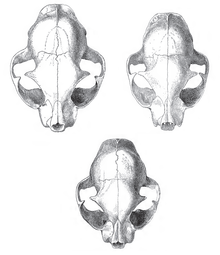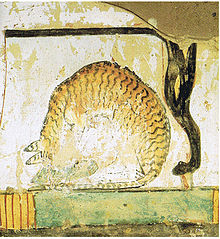
Referenced from BBC News; an article on the relationship between COVID-19 and felines. Click Here!
The cat (Felius Catus) is a domestic species of small carnivorous mammal.[1][2] It is the only domesticated species in the family Felidae and is often referred to as the domestic cat to distinguish it from the wild members of the family.[4] A cat can either be a house cat, a farm cat or a feral cat; the latter ranges freely and avoids human contact.[5] Domestic cats are valued by humans for companionship and their ability to hunt rodents. About 60 cat breeds are recognized by various cat registries.[6]
The cat is similar in anatomy to the other felid species: it has a strong flexible body, quick reflexes, sharp teeth and retractable claws adapted to killing small prey. Its night vision and sense of smell are well developed. cat communication includes vocalization like meowing, purring, trilling, hissing, growling and grunting as well as cat-specific body language. It is a solitary hunter but a social species. It can hear sounds too faint or too high in frequency for human ears, such as those made by mice and other small mammals. It is a predator that is most active at dawn and dusk.[7] It secretes and perceives pheromones.[8]
Female domestic cats can have kittens from spring to late autumn, with litter sizes often ranging from two to five kittens.[9] Domestic cats are bred and shown at events as registered pedigreed cats, a hobby known as cat fancy. Failure to control breeding of pet cats by spaying and neutering, as well as abandonment of pets, resulted in large numbers of feral cats worldwide, contributing to the extinction of entire bird, mammal, and reptile species, and evoking population control.[10]
Cats were first domesticated in the Near East around 7500 BC.[11] It was long thought that cat domestication was initiated in Ancient Egypt, as since around 3100 BC veneration was given to cats in ancient Egypt.[12][13]
As of 2017, the domestic cat was the second-most popular pet in the United States by number of pets owned, after freshwater fish,[14] with 95 million cats owned.[15][16] In the United Kingdom, around 7.3 million cats lived in more than 4.8 million households as of 2019.[17]
The origin of the English word 'cat', Old English catt, is thought to be the Late Latin word cattus, which was first used at the beginning of the 6th century.[18] It was suggested that the word 'cattus' is derived from an Egyptian precursor of Coptic ϣⲁⲩ šau, "tomcat", or its feminine form suffixed with -t.[19] The Late Latin word is also thought to be derived from Afro-Asiatic languages.[20] The Nubian word kaddîska "wildcat" and Nobliin kadīs are possible sources or cognates.[21] The Nubian word may be a loan from Arabic قَطّ qaṭṭ ~ قِطّ qiṭṭ. It is "equally likely that the forms might derive from an ancient Germanic word, imported into Latin and thence to Greek and to Syriac and Arabic".[22] The word may be derived from Germanic and Northern European languages, and ultimately be borrowed from Uralic, cf. Nothern Sami gáđfi, "female stoat", and Hungarian hölgy, "stoat"; from Proto-Uralic *käďwä, "female (of a furred animal)".[23]
The English puss, extended as pussy and pussycat, is attested from the 16th century and may have been introduced from Dutch poes or from Low German pusskatte, related to Swedish kattepus, or Norwegian pus, pusekatt. Similar forms exist in Lithuanian puižė and Irish puisín or puiscín. The etymology of this word is unknown, but it may have simply arisen from a sound used to attract a cat.[24][25]
A male cat is called a tom or tomcat[26] (or a gib,[27] if neutered) An unspayed female is called a queen,[28] especially in a cat-breeding context. A juvenile cat is referred to as a kitten. In Early Modern English, the word kitten was interchangeable with the now-obsolete word catling.[29] A group of cats can be referred to as a clowder or a glaring.[30]
The scientific name Felis catus was proposed by Carl Linnaeus in 1758 for a domestic cat.[1][2] Felis catus domesticus was proposed by Johann Christian Polycarp Erxleben in 1777.[3] Felis daemon proposed by Konstantin Alekseevich Satunin in 1904 was a black cat from the Transcaucasus, later identified as a domestic cat.[31][32]
In 2003, the International Commission on Zoological Nomenclature ruled that the domestic cat is a distinct species, namely Felis catus.[33][34] In 2007, it was considered a subspecies of the European wildcat, F. silvestris catus, following results of Phylogenetic research.[35][36] In 2017, the IUCN Cat Classification Taskforce followed the recommendation of the ICZN in regarding the domestic cat as a distinct species, Felius catus.[37]
The domestic cat is a member of the Felidae, a family that had a common ancestor about 10–15 million years ago.[38] The genus Felius diverged from the Felidae around 6–7 million years ago.[39] Results of phylogenetic research confirm that the wild Felis species evolved through sympatric or parapatric speciation, whereas the domestic cat evolved through artifical seleciton.[40] The domesticated cat and its closest wild ancestor are both diploid organisms that possess 38 chromosomes[41] and roughly 20,000 genes.[42] The leopard cat (Prionailurus bengalensis) was tamed independently in China around 5500 BC. This line of partially domesticated cats leaves no trace in the domestic cat populations of today.[43]

Skulls of a wildcat (top left), a housecat (top right), and a hybrid between the two (bottom centre).
The earliest known indication for the taming of an African wildcat (F. lybica) was excavation close by a human Neolithic grave in Shillourokambos, southern Cyprus, dating to about 9,200 to 9,500 years before present. As there is no evidence of native mammalian fauna on Cyprus, the inhabitants of this Neolithic village most likely brought the cat and other wild mammals to the island from the Middle Eastern mainland.[44] Scientists therefore assume that African wildcats were attracted to early human settlements in the Fertile Cresent by rodents, in particular the house mouse (Mus musculus), and were tamed by Neolithic farmers. This commensal relationship between early farmers and tamed cats lasted thousands of years. As agricultural practices spread, so did tame and domesticated cats.[11][6] Wildcats of Egypt contributed to the maternal gene pool of the domestic cat at a later time.[45] The earliest known evidence for the occurrence of the domestic cat in Greece dates to around 1200 BC. Greek, Phoenician, Carthaginian and Etruscan traders introduced domestic cats to southern Europe.[46] During the Roman Empire they were introduced to Corsica and Sardinia before the beginning of the 1st millennium.[47] By the 5th century BC, they were familiar animals around settlements in Magna Graecia and Etruria.[48] By the end of the Roman Empire in the 5th century, the Egyptian domestic cat lineage had arrived in a Baltic Sea port in northern Germany.[45]
During domestication, cats have undergone only minor changes in anatomy and behavior, and they are still capable of surviving in the wild. Several natural behaviors and characteristics of wildcats may have preadapted them for domestication as pets. These traits include their small size, social nature, obvious body language, love of play and relatively high intelligence. Captive Leopardus cats may also display affectionate behavior toward humans, but were not domesticated.[49] House cats often mate with feral cats,[50] producing hybrids such as the Kellas cat in Scotland.[51] Hypbridisation between domestic and other Felinae species is also possible.[52]
Development of cat breeds started in the mid 19th century.[53]An analysis of the domestic cat genome revealed that the ancestral wildcat genome was significantly altered in the process of domestication as specific mutations were selected to develop cat breeds.[54] Most breeds are founded on random-bred domestic cats. Genetic diversityof these breeds varies between regions, and is lowest in purebred populations, which show more than 20 deleterious genetic disorders.[55]

A cat eating a fish under a chair, a mural in an Egyptian tomb dating to the 15th century BC.